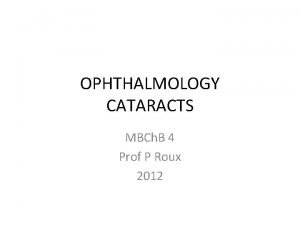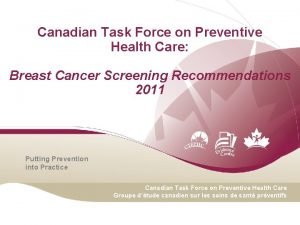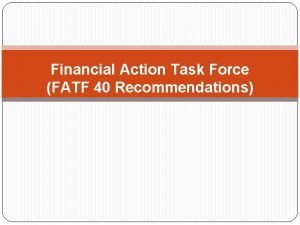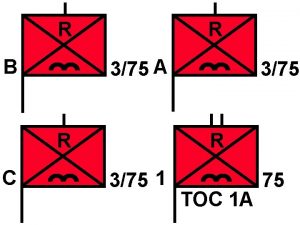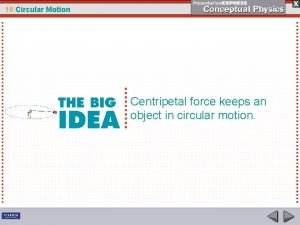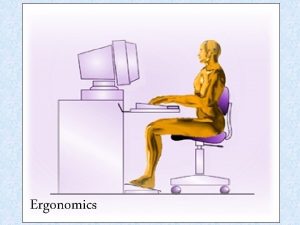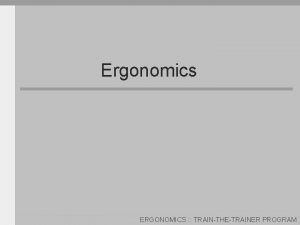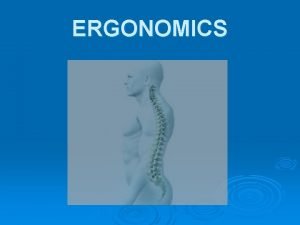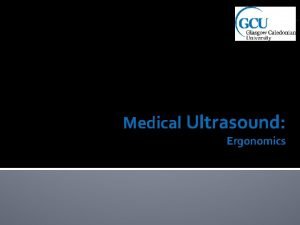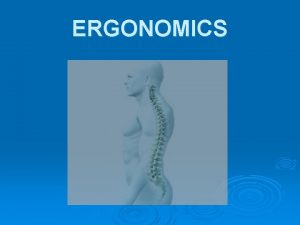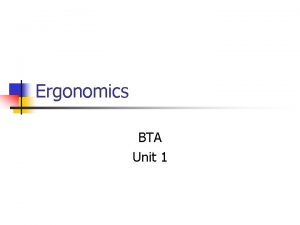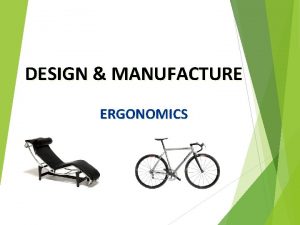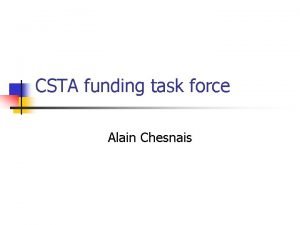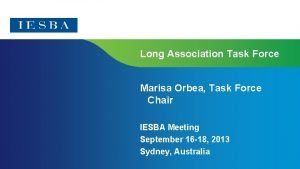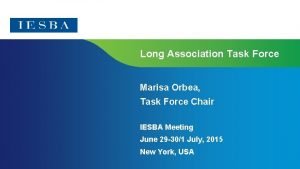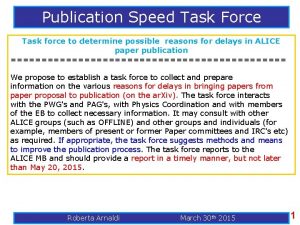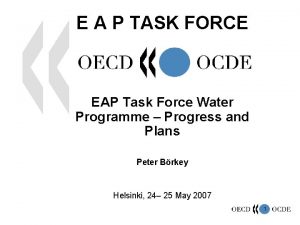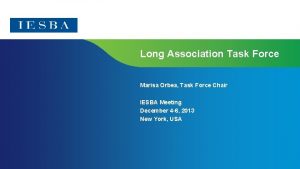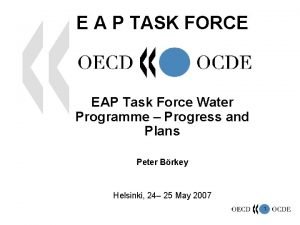AAO Ergonomics Symposium AAO Ergonomics Task Force Presenters

















































- Slides: 49

AAO Ergonomics Symposium AAO Ergonomics Task Force

Presenters • Jeffrey L. Marx, MD • Scott Olitsky, MD • Jeremy Wehking, PT, OCS, FAAOMPT, PRC

Financial Disclosure • The presenters do not have any financial interests or relationships to disclose.

AAO Ergonomics Task Force Members • • Jeffrey Marx MD, Chair Keith Baratz MD Anna Kitzmann MD Thomas Liesegang MD Meher Yepremyan MD Martin Wand MD George Bartley MD, Tamara Fountain MD and Ruth Williams MD, ex-officio Jane Aguire and Jill Hartle, AAO staff

• • • Ergonomics, as defined by the Board of Certification for Professional Ergonomists (BCPE), "is a body of knowledge about human abilities, human limitations and human characteristics that are relevant to design. Ergonomic design is the application of this body of knowledge to the design of tools, machines, systems, tasks, jobs, and environments for safe, comfortable and effective human use" (BCPE, 1993). Greek “Ergos” = Work Greek “Nomos” = Study of

Common Acronyms • • • MSD = Musculoskeletal Disorder CTD = Cumulative Trauma Disorder RSI = Repetitive Strain Injury WMSD = Work Related Musculoskeletal Disorders All refer to wear and tear on the body over time that can lead to an injury

Incidence of MSDs in Ophthalmologists Recent Evidence

• • • Prevalence of MSDs in Ophthalmologists Survey of 697 ophthalmologists in northeastern US Self-reported neck, upper extremity or lower back symptoms in prior month was 52% – Lower back pain: 39% – Upper extremity pain: 33% – Neck pain: 33% 15% were slightly to moderately limited in their work as a result of these symptoms Dhimitri KC et al. Symptoms of musculoskeletal disorders in ophthalmologists. Am J Ophthalmol 2005; 139: 179 -81.

• • • Prevalence of MSDs in Ophthalmologists Neck Pain Associated with: – >100 encounters/week – >6 lasers/week – >4 surgeries/week Back Pain Associated with: – >6 lasers/week – Job stress Upper Extremity Pain Associated with: – Female gender Dhimitri KC et al. Symptoms of musculoskeletal disorders in ophthalmologists. Am J Ophthalmol 2005; 139: 179 -81

Risk of MSDs in Other Industries Based upon Gender • Musculoskeletal Disorders, particularly those of the upper body are seen across many industries- both health care and non-health care. • Employed women are 2 to 5 times more likely than men to report MSD problems • Prevailing explanations of women’s excess health risk revolve around 2 basic propositions – Work Family Model- Higher demands and constraints that women face or women are more affected/vulnerable to health impact of particular demands/constraints. May be affected by accumulation of differences in exposures at work and at home. – Vulnerability Model- Sex linked biological factors such as hormones or physiology

• • Prevalence of MSDs in Ophthalmologists Potential Relationships of Female Ophthalmologists increased prevalence of MSDs and Vulnerability Model Women were more likely to report neck pain, upper extremity pain and weakness despite seeing fewer patients and performing fewer procedures per week – Shorter stature – Shorter arms/reach – Clothing necessitates accommodation at slit lamp Dhimitri KC et al. Symptoms of musculoskeletal disorders in ophthalmologists. Am J Ophthalmol 2005; 139: 179 -81

Prevalence of MSDs • • • Survey of ophthalmologists and family medicine doctors at University of Iowa and Mayo Clinic 186 surveys completed by 94 ophthalmologists and 92 family medicine doctors Symptom quality and severity during 30 day period prior to questionnaire Kitzmann et al. A survey study of musculoskeletal disorders among eye care physicians compared to family medicine physicians. Ophthalmology, February 2012.

Prevalence of MSDs • Neck Pain – 46% ophthalmologists vs. 21% family medicine doctors • Hand/Wrist Pain – 17% ophthalmologists vs. 7% family medicine doctors • Lower Back Pain – 26% ophthalmologists vs. 9% family medicine doctors Kitzmann et al. A survey study of musculoskeletal disorders among eye care physicians compared to family medicine physicians. Ophthalmology February 2012

Incidence of MSDs • It is anticipated that the number of overuse injuries will increase with: – Increasing demand for services – Increasing age of practitioners • What are the costs of these injuries both professionally and personally? – Loss of work days? – Loss of income? – Affects leisure activities?

Activity Factors • • • Awkward Postures Repetitive Motions Long Durations High Forces Environmental – Vibration – Cold or Heat Why Not Everyone? – Similar Activity Factors with Different Results – Why?

Personal Factors • • Age Gender Height/Weight Ratio Hobbies – Computer Use (at home) – Sports – Yard Work • • Exercise/activity level Smoking

Site Observations: Clinic Exposures Opportunities for Improvement Now!

Site Observations: The Clinic Reviewing Patient Information C-Spine Awkward neck and back posture

Site Observations: The Clinic Reviewing Patient Information

Site Observations: The Clinic Positioning for General Exam For appropriate patients, consider the use of a foam back wedge that will decrease how far a patient is from the front of the seat edge.

Have patient move or lean forward so you do not have to lean forward

Site Observations: The Clinic Positioning for General Exam

Custom SL table with less deep top and with sloping edge (Keith Baratz)

Site Observations: The Clinic Using the Slit Lamp Adjust the oculars to assist or consider after market oculars

Site Observations: The Clinic Using the Slit Lamp

Site Observations: The Clinic Using the Slit Lamp: Wrist Postures

Site Observations: The Clinic Using the Slit Lamp: Pinching Condensing Lens

Site Observations: The Clinic Indirect Ophthalmoscopy

Site Observations: The Clinic Indirect Ophthalmoscopy

OUCH!!

Site Observations: The Clinic Giving Injections

Site Observations: The Clinic Giving Injections

Site Observations: The Clinic Giving Injections: The Sharps Container

Site Observations: The Clinic Support Staff Tasks: Talk to the Staff Sharps container located underneath the sink causing awkward postures Searching for supplies in low drawers. Consider a 5 S initiative to standardize the location of items to reduce searching. Label locations. New room designs can have supply drawers located from thigh to mid

Site Observations: The Clinic Support Staff Tasks

Office Ergonomics: Typical Exposures and Better Postures

Do not cradle your phone

Site Observations: Operating Room Exposures Opportunities for Improvement

In the Operating Room • Cranking bed • Awkward Posture

In the Operating Room • Electric bed positioning eliminates some of the manual lifting/lowering patients

In the Operating Room • • • Draping and preparing the patient Physician has his back bent forward and arms abducted Raising height of bed would reduce this posture

In the Operating Room • • • Retro/Peribulbar injections The physician’s back is bent forward and held in this position for some period of time. Raising the bed would help reduce this awkward posture

In the Operating Room • • • Back and neck position while using microscope is critical In this picture, the physician’s neck is in extension. The eyepieces need to be set slightly below sitting eye height

In the Operating Room • • • Sustained shoulder retraction Holding shoulders in this position provides stability, but stresses trapezius muscle and may lead to shoulder and back pain. Armrests on stools or wrist rests can provide support forearms

In the Operating Room • • Slide upper left: Flexed kyphotic neck and back without use of lumbar support Slide upper right: Neutral position with proper use of back support.

In the Operating Room • • • Back tilted due to different height profiles of the foot pedals. Raising the microscope foot pedal slightly with towels could place the feet at a similar height and reduce tilting of trunk Using Towels underneath can also assist with positioning the food pedals

In the Operating Room • • Upper left: Flexed/kyphotic neck and back with microscope positioned vertically Upper right: Neutral spinal curvature and reduced musculoskeletal workload with the microscope tilted to accommodate a more neutral posture

In the Operating Room • • Prolonged precision gripping of instruments Attempt to be as relaxed as possible while gripping instruments for prolonged periods Periodically pause and stretch upper extremities with at least a finger flexor and a finger fan stretch. When possible, pause, stand perform a low back stretch

Final Thoughts Good ergonomic practices need to be utilized early in life both in your personal and professional life Results will be slow, but benefits will be lifelong. Dutch Dental Society instituted ergonomic recommendations: 50% dentists adopted all or most and 40% more adopted some of the recommendations; 72% had decreased or total resolution of their main MSD complaint. Dreoze & Jonsson, Work 2005
 Hku faa
Hku faa Aao
Aao Famous british tv presenters
Famous british tv presenters Presenter's name
Presenter's name Thank you to all presenters
Thank you to all presenters Job title example
Job title example Calender presenters
Calender presenters Title of presenter
Title of presenter Atv presenters
Atv presenters Presenter's name
Presenter's name Presenters name
Presenters name The loop presenters
The loop presenters Tiered task bias task
Tiered task bias task Green ribbon task force
Green ribbon task force Social exclusion task force
Social exclusion task force Global harmonization task force
Global harmonization task force React task force
React task force Iowa food protection task force
Iowa food protection task force North orange county public safety task force
North orange county public safety task force Princeton policy task force
Princeton policy task force Einen appell schreiben
Einen appell schreiben Social performance task force
Social performance task force Iowa food protection task force
Iowa food protection task force Apa presidential task force on evidence-based practice
Apa presidential task force on evidence-based practice Ctfphc
Ctfphc Java dynamic management kit
Java dynamic management kit S330 nwcg
S330 nwcg A1 flow equalization basin
A1 flow equalization basin Marketing task force
Marketing task force Financial action task force 40 recommendations
Financial action task force 40 recommendations Enemy symbols army
Enemy symbols army Jidf
Jidf Anchor institutions task force
Anchor institutions task force Glencoe sustainability task force
Glencoe sustainability task force Expected enemy military symbol
Expected enemy military symbol Born with a mic flocabulary
Born with a mic flocabulary Combined joint task force horn of africa
Combined joint task force horn of africa If you whirl a tin can on the end of a string
If you whirl a tin can on the end of a string Is air resistance a noncontact force
Is air resistance a noncontact force Normal force and gravitational force
Normal force and gravitational force Non-contact forces portfolio
Non-contact forces portfolio The ratio of resistance force to effort force
The ratio of resistance force to effort force Internal forces examples
Internal forces examples Which arrow below represents the direction of acceleration
Which arrow below represents the direction of acceleration Why electric field is conservative
Why electric field is conservative Net force
Net force Long range force vs contact force
Long range force vs contact force Centripetal force and gravitational force
Centripetal force and gravitational force Centripetal force in geography
Centripetal force in geography Chelsea modular homes
Chelsea modular homes

